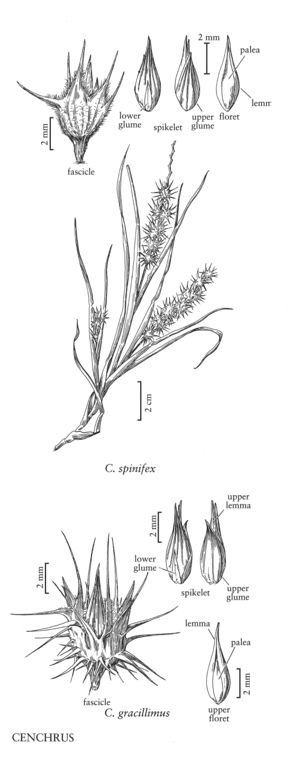Difference between revisions of "Cenchrus spinifex"
FNA>Volume Importer |
FNA>Volume Importer |
||
| Line 7: | Line 7: | ||
|synonyms={{Treatment/ID/Synonym | |synonyms={{Treatment/ID/Synonym | ||
|name=Cenchrus pauciflorus | |name=Cenchrus pauciflorus | ||
| − | |authority= | + | |authority= |
| + | |rank=species | ||
}} {{Treatment/ID/Synonym | }} {{Treatment/ID/Synonym | ||
|name=Cenchrus incertus | |name=Cenchrus incertus | ||
| − | |authority= | + | |authority= |
| + | |rank=species | ||
}} {{Treatment/ID/Synonym | }} {{Treatment/ID/Synonym | ||
|name=Cenchrus bambusoides | |name=Cenchrus bambusoides | ||
| − | |authority= | + | |authority= |
| + | |rank=species | ||
}} | }} | ||
|hierarchy=Poaceae;Poaceae subfam. Panicoideae;Poaceae tribe Paniceae;Cenchrus;Cenchrus spinifex | |hierarchy=Poaceae;Poaceae subfam. Panicoideae;Poaceae tribe Paniceae;Cenchrus;Cenchrus spinifex | ||
| Line 26: | Line 29: | ||
-->{{Treatment/Body | -->{{Treatment/Body | ||
|distribution=D.C;Maine;Vt.;Fla.;Puerto Rico;N.Mex.;Tex.;La.;Tenn.;N.C.;S.C.;Nev.;Va.;Virgin Islands;Calif.;Ala.;Ark.;Ga.;Ariz.;Md.;Kans.;Okla.;Mass.;Miss.;Ky. | |distribution=D.C;Maine;Vt.;Fla.;Puerto Rico;N.Mex.;Tex.;La.;Tenn.;N.C.;S.C.;Nev.;Va.;Virgin Islands;Calif.;Ala.;Ark.;Ga.;Ariz.;Md.;Kans.;Okla.;Mass.;Miss.;Ky. | ||
| − | |discussion=<p>Cenchrus spinifex is common in sandy woods, fields, and waste places throughout the southern United States and southwards into South America. It may be more widespread than shown in the northern portion of the contiguous United States because it has often been confused with C. tribuloides. Cenchrus spinifex differs from C. tribuloides in its glabrous or less densely pubescent fascicles, narrower inner bristles, and larger number of bristles. It has also been confused with C. longispinus but differs in having shorter spikelets, fewer bristles overall, wider inner bristles, and outer bristles that are usually flattened rather than usually terete.</p> | + | |discussion=<p><i>Cenchrus spinifex</i> is common in sandy woods, fields, and waste places throughout the southern United States and southwards into South America. It may be more widespread than shown in the northern portion of the contiguous United States because it has often been confused with <i>C. tribuloides</i>. <i>Cenchrus spinifex</i> differs from <i>C. tribuloides</i> in its glabrous or less densely pubescent fascicles, narrower inner bristles, and larger number of bristles. It has also been confused with <i>C. longispinus</i> but differs in having shorter spikelets, fewer bristles overall, wider inner bristles, and outer bristles that are usually flattened rather than usually terete.</p> |
|tables= | |tables= | ||
|references= | |references= | ||
| Line 35: | Line 38: | ||
-->{{#Taxon: | -->{{#Taxon: | ||
name=Cenchrus spinifex | name=Cenchrus spinifex | ||
| − | |||
|authority=Cav. | |authority=Cav. | ||
|rank=species | |rank=species | ||
| Line 42: | Line 44: | ||
|basionyms= | |basionyms= | ||
|family=Poaceae | |family=Poaceae | ||
| − | |illustrator=Linda A. Vorobik | + | |illustrator=Linda A. Vorobik;Annaliese Miller |
| + | |illustration copyright=Utah State University | ||
|distribution=D.C;Maine;Vt.;Fla.;Puerto Rico;N.Mex.;Tex.;La.;Tenn.;N.C.;S.C.;Nev.;Va.;Virgin Islands;Calif.;Ala.;Ark.;Ga.;Ariz.;Md.;Kans.;Okla.;Mass.;Miss.;Ky. | |distribution=D.C;Maine;Vt.;Fla.;Puerto Rico;N.Mex.;Tex.;La.;Tenn.;N.C.;S.C.;Nev.;Va.;Virgin Islands;Calif.;Ala.;Ark.;Ga.;Ariz.;Md.;Kans.;Okla.;Mass.;Miss.;Ky. | ||
|reference=None | |reference=None | ||
| Line 48: | Line 51: | ||
|publication year= | |publication year= | ||
|special status= | |special status= | ||
| − | |source xml=https:// | + | |source xml=https://jpend@bitbucket.org/aafc-mbb/fna-data-curation.git/src/f50eec43f223ca0e34566be0b046453a0960e173/coarse_grained_fna_xml/V25/V25_1376.xml |
|subfamily=Poaceae subfam. Panicoideae | |subfamily=Poaceae subfam. Panicoideae | ||
|tribe=Poaceae tribe Paniceae | |tribe=Poaceae tribe Paniceae | ||
Revision as of 20:33, 16 December 2019
Plants annual or perennial but short-lived; tufted. Culms 30-100 cm, geniculate. Sheaths compressed, glabrous or sparsely pilose; ligules 0.5-1.4 mm; blades 3-28 cm long, (1)3-7.2 mm wide, glabrous or sparsely long-pilose adaxially. Panicles 3-5(8.5) cm; fascicles 5.5-10.2 mm long, 2.5-5 mm wide, imbricate, ovoid to globose, glabrous or sparesely to moderately pubescent; outer bristles, when present, mostly flattened; inner bristles 8-40 (rarely more), 2-5.8 mm long, 1-2 mm wide, fused at least 1/2 their length, forming a distinct cupule, the distal portions usually diverging from the cupule at multiple, irregular intervals, sometimes diverging at more or less the same level, ciliate at the base, pubescent, stramineous to mauve or purple, flattened. Spikelets 2-4 per fascicle, 3.5-5.9 mm, glabrous. Lower glumes 1-3.3 mm; upper glumes (2.8)3.5-5 mm, 5-7-veined; lower florets sometimes staminate; lower lemmas 3-5(5.9) mm, 5-7-veined; lower paleas sometimes reduced or absent; anthers 1.3-1.6 mm; upper lemmas 3.5-5(5.8) mm; anthers 0.5-1.2 mm. Caryopses about 2.5 mm long, 1-2 mm wide, ovoid. 2n = 34 (32).
Distribution
D.C, Maine, Vt., Fla., Puerto Rico, N.Mex., Tex., La., Tenn., N.C., S.C., Nev., Va., Virgin Islands, Calif., Ala., Ark., Ga., Ariz., Md., Kans., Okla., Mass., Miss., Ky.
Discussion
Cenchrus spinifex is common in sandy woods, fields, and waste places throughout the southern United States and southwards into South America. It may be more widespread than shown in the northern portion of the contiguous United States because it has often been confused with C. tribuloides. Cenchrus spinifex differs from C. tribuloides in its glabrous or less densely pubescent fascicles, narrower inner bristles, and larger number of bristles. It has also been confused with C. longispinus but differs in having shorter spikelets, fewer bristles overall, wider inner bristles, and outer bristles that are usually flattened rather than usually terete.
Selected References
None.
